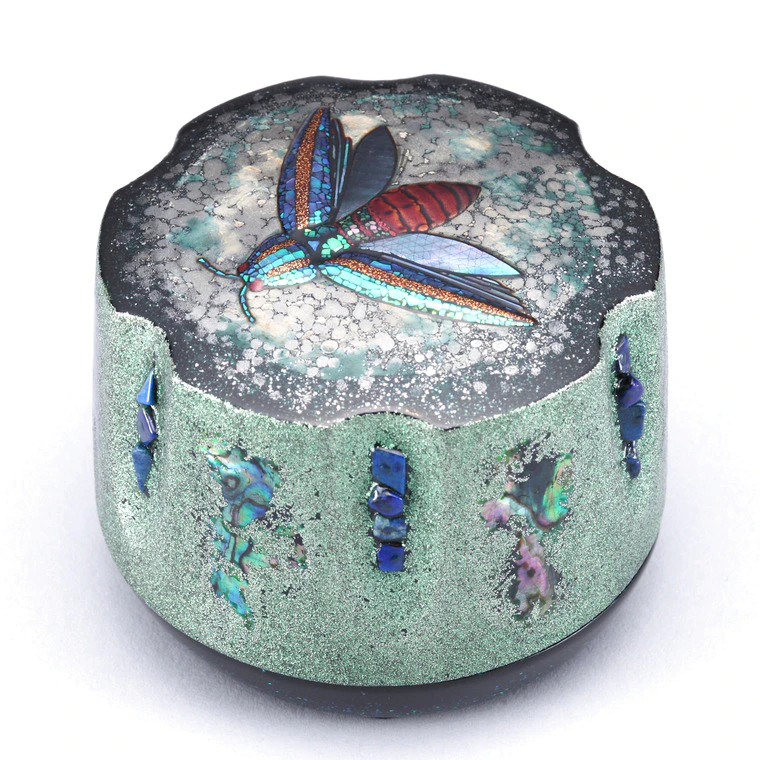Makie Box with Jewel Beetle Design in Mother-of-Pearl Inlay "Flying"
H 6.2 x W 7.8 x D 7.8 cm,Year.2023- according to today's currency rate
- shipping fees not included
Keiji Onihira
1973 -- Lacquerware
- Price Range Please Inquire
- Awards at Japan Kōgei Assoc. Exhibitions : 4
About the Artwork
"The jewel beetle is a thin, long, rice shaped beetle. It is a beautiful insect with overall metallic green shine and rainbow-like red and green lines on its back.
As its natural enemy, birds are scared of ""things that change color"", it is said that the metallic shine of this beetle keeps birds away.
It flies above broadleaf trees such as nettle trees and zelkova. It is very cautious and stops moving when someone comes nearby. If you move closer to it, it will fly away or drop into a bush and disappear.
Its wings do not change color even after their death, so they have been used for decorating the ""Tamamushi-no-Zushi"", a treasure of the Horyuji Temple.
There is an old saying that if you put a jewel beetle wing in your drawer, you will get more kimonos.
I hope people will cherish this as a jewel beetle box that brings happiness. "
Description
-
CategoryLacquerware
-
MaterialsUrushi lacquer, Hemp cloth, White-lipped pearl oyster, Abalone shell, South sea abalone shell (tamamushi shell), Gold powder, Silver powder, Platinum powder, Pigments, Dry lacquer (partially wood based), Mexican abalone shells, Lapis lazuli, Platinum, Gold, Silver
-
DimensionsH 6.2 x W 7.8 x D 7.8 cm
-
Year of creation2023
-
RarityUnique
-
Paulownia BoxIncluded
-
Artist SignatureSigned (name of artwork, paulownia box)
Techniques Used
Dry lacquer
For works of dry lacquer (kanshitsu), first a clay form is created and plaster is used to take a mold of the form. Next, repeated layers of hemp cloth and lacquer are applied to the mold until they are built up to the desired thickness. Finally, the mold is removed and additional coats of lacquer are applied to finish the piece. The hemp fibers are strengthened when the lacquer bonds with them, making dry lacquer an excellent technique for creating sturdy forms with a significant degree of freedom.
Urushi-e
Urushi-e (“lacquer pictures”) is a decorative technique that consists of motifs painted in colored lacquer. Urushi-e is the oldest and most fundamental decorative lacquer technique.
Maki-e
Maki-e (literally “sprinkled pictures”) is a representative lacquerware technique that originated in Japan around 1,200 years ago. Maki-e is done by painting lacquer motifs on the surface of a piece using a fine brush and then sprinkling gold powder onto the lacquer before it hardens, producing luxurious decorations.
Mother-of-pearl inlay (Raden)
Mother-of-pearl inlay (Raden) is a decorative technique that uses the iridescent inner layer of abalone shell, turban shell, pearl oyster shell, or other mollusk shells. The technique came to Japan from China 1,300 years ago, and pieces featuring mother-of-pearl inlay are included among the artifacts at the Shōsōin Repository in Nara.
Selected exhibitions
- The 63rd Ishikawa Traditional Kōgei Exhibition (2023)
- Selected

